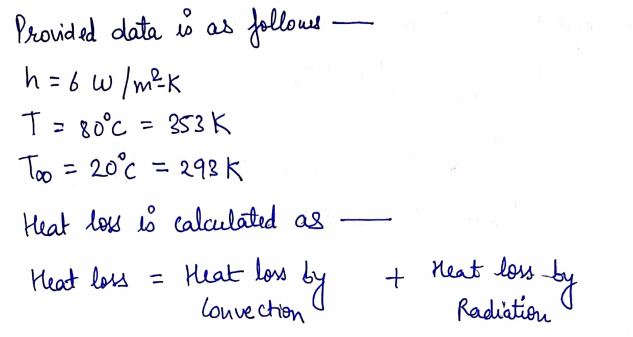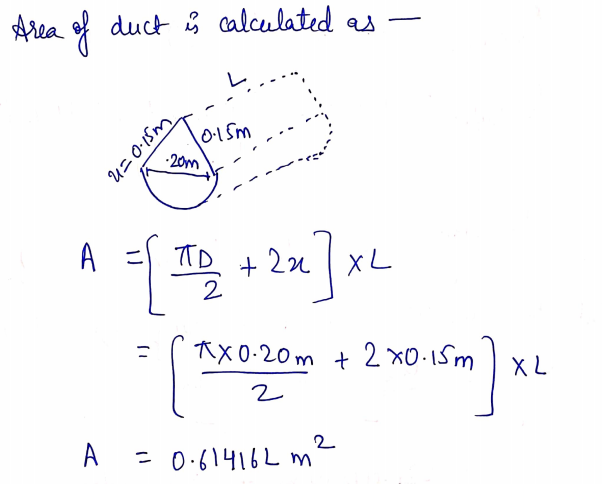A duct has a cross sectional area as shown below is used to carry heated water, the external surface of the pipe is subjected to a convective heat transfer coefficient of h = 6 W/m°K, find the heat loss by convection per meter length of the duct when the external surface temperature is 80°C and the surroundings are at 20°C. Assuming black body radiation what is the heat loss by radiation?. 15 cm 15 cm R = 10 cm 15 cm 15 cm R = 10 cm
A duct has a cross sectional area as shown below is used to carry heated water, the external surface of the pipe is subjected to a convective heat transfer coefficient of h = 6 W/m°K, find the heat loss by convection per meter length of the duct when the external surface temperature is 80°C and the surroundings are at 20°C. Assuming black body radiation what is the heat loss by radiation?. 15 cm 15 cm R = 10 cm 15 cm 15 cm R = 10 cm
Introduction to Chemical Engineering Thermodynamics
8th Edition
ISBN:9781259696527
Author:J.M. Smith Termodinamica en ingenieria quimica, Hendrick C Van Ness, Michael Abbott, Mark Swihart
Publisher:J.M. Smith Termodinamica en ingenieria quimica, Hendrick C Van Ness, Michael Abbott, Mark Swihart
Chapter1: Introduction
Section: Chapter Questions
Problem 1.1P
Related questions
Question
In this question .. how to get the*** surface area ****of the shape attached
we should use area or circumfrence rules ???
and what will be Q value

Transcribed Image Text:A duct has a cross sectional area as shown below is used to carry heated water, the external
surface of the pipe is subjected to a convective heat transfer coefficient of h = 6 W/m°K, find
the heat loss by convection per meter length of the duct when the external surface
temperature is 80°C and the surroundings are at 20°C. Assuming black body radiation what is
the heat loss by radiation?.
15 cm
15 cm
R = 10 cm

Transcribed Image Text:15 cm
15 cm
R = 10 cm
Expert Solution
Step 1

Step 2

Step by step
Solved in 4 steps with 4 images

Knowledge Booster
Learn more about
Need a deep-dive on the concept behind this application? Look no further. Learn more about this topic, chemical-engineering and related others by exploring similar questions and additional content below.Recommended textbooks for you

Introduction to Chemical Engineering Thermodynami…
Chemical Engineering
ISBN:
9781259696527
Author:
J.M. Smith Termodinamica en ingenieria quimica, Hendrick C Van Ness, Michael Abbott, Mark Swihart
Publisher:
McGraw-Hill Education

Elementary Principles of Chemical Processes, Bind…
Chemical Engineering
ISBN:
9781118431221
Author:
Richard M. Felder, Ronald W. Rousseau, Lisa G. Bullard
Publisher:
WILEY

Elements of Chemical Reaction Engineering (5th Ed…
Chemical Engineering
ISBN:
9780133887518
Author:
H. Scott Fogler
Publisher:
Prentice Hall

Introduction to Chemical Engineering Thermodynami…
Chemical Engineering
ISBN:
9781259696527
Author:
J.M. Smith Termodinamica en ingenieria quimica, Hendrick C Van Ness, Michael Abbott, Mark Swihart
Publisher:
McGraw-Hill Education

Elementary Principles of Chemical Processes, Bind…
Chemical Engineering
ISBN:
9781118431221
Author:
Richard M. Felder, Ronald W. Rousseau, Lisa G. Bullard
Publisher:
WILEY

Elements of Chemical Reaction Engineering (5th Ed…
Chemical Engineering
ISBN:
9780133887518
Author:
H. Scott Fogler
Publisher:
Prentice Hall


Industrial Plastics: Theory and Applications
Chemical Engineering
ISBN:
9781285061238
Author:
Lokensgard, Erik
Publisher:
Delmar Cengage Learning

Unit Operations of Chemical Engineering
Chemical Engineering
ISBN:
9780072848236
Author:
Warren McCabe, Julian C. Smith, Peter Harriott
Publisher:
McGraw-Hill Companies, The